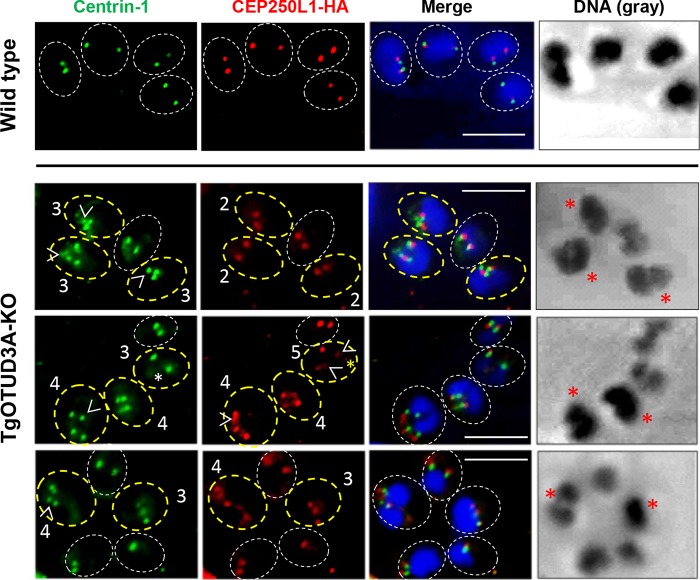FIG 5 .
Reduplication and transient dysregulation in the stoichiometry of the inner and outer cores drive the plasticity of the replication mode. The 1st row displays wild-type parasites both primed for mitosis (based on nuclear size and intensity) and undergoing mitosis, possessing matched outer (Centrin-1, green) and inner (CEP250L1-HA, red) cores in close apposition to each other and the nucleus (Merge). The 2nd and 3rd rows show the diverse phenotypes associated with the TgOTUD3A-KO mutant. These include instances of two matched inner and outer centrosome cores (circled in white dashed lines), similar to the phenotype of wild-type parasites. TgOTUD3A-KO parasites with more than 2 inner or outer cores are circled in yellow dashed lines. These include parasites within which the number of outer cores (Centrin-1) exceeds the number of inner cores (CEP250L1-HA); the extra cores are marked with open white arrowheads. The 1st row for the TgOTUD3A-KO line displays three parasites containing mismatched outer and inner cores. These parasites display aberrant nuclear morphologies (red asterisks), with two nuclei presenting as larger masses (9 o’clock and 11 o’clock) relative to the sizes of the mitotically resolved nuclei within the normal parasite (circled in white dashed lines). The third parasite (5 o’clock) appears to have undergone one round of mitosis but displays unevenly sized nuclei. The 2nd row for the TgOTUD3A-KO line displays a parasite with both higher numbers and mismatch (in terms of their relative positioning) of both outer and inner cores (Centrin-1, 7 o’clock) that possesses 2 intensely labeled nuclei of equivalent size. In addition, this vacuole contains a parasite with additional inner cores (CEP250L1-HA, 2 o’clock). In this case, the weak signal of an outer core (Centrin-1, white asterisk) and some inner cores (CEP250L1-HA, yellow asterisk) may suggest an immature centrosome or breakdown products of a centrosome. Of note, the parasite in the center (5 o'clock) possesses 4 matched Centrin-1- and CEP250L1-HA-labeled centrosomes and appears, based on the intensity of the DNA synthesis, closer to the end of replication and poised for the second round of symmetrical mitosis and cytokinesis. Of the two TgOTUD3A-KO parasites displayed in the 3rd row with more than 2 centrosome cores, one (10 o’clock) possesses matched though spatially disorganized centrosomes together with 2 largely matched nuclei. The second aberrant parasite (3 o’clock) exhibits an intensely labeled apparently polyploid nucleus within which the stoichiometry between the inner and outer cores appears to have been resolved. The resolution of transient imbalances in favor of either the inner or outer core appears to be linked to an aberrant S phase, promoting either a schizogony-like or endopolygeny-like nuclear cycle. In all instances, the scale bars represent 10 μm.

